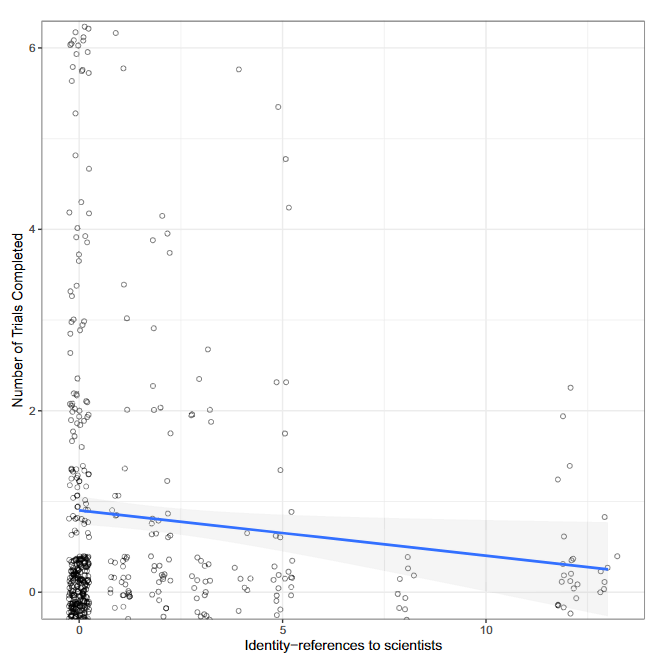Hanging up your “scientist hat” and adopting better language could increase science engagement
By Sarah Ferguson
Title: Asking young children to “do science” instead of “be scientists” increases science engagement in a randomized field experiment
Author(s) and Year: Marjorie Rhodes, Amanda Carderelli, Sarah-Jane Leslie, 2020
Journal: Proceedings of the National Academy of Sciences (PNAS) (open access)
https://doi.org/10.1073/pnas.1919646117
TL;DR: It is typically assumed that asking children to think like or be a scientist will lead to better science engagement and learning outcomes. This is an example of identity-cuing language. It asks children to think of “scientist” as a special type of person and then behave that way. However, asking kids to “be a scientist” might not be working to engage children with science. A recent study found that children who learned a science lesson with identity-cuing language reported being less interested in science and gave up on science activities earlier.
Why I chose this paper: After having worked for multiple science engagement programs for children, I started becoming more curious about the best practices for communicating science to children. The phrase “think like a scientist” is repeated frequently in classrooms and at school science nights, so I was surprised to learn that it might be not working to engage children with science.
“Think like a scientist!” is a common refrain from teachers and science communicators alike during science lessons or activities. Even today if you walk into a room and say “Bill Nye”, your audience is sure to shout back “the science guy!”. These are examples of “identity-cueing” language, or language that encourages children to imagine science in terms of a set type of person who does science. Many educators use these language cues to encourage children to adopt the identity of “scientist” because they believe it increases science understanding and engagement. However, telling children to “be a scientist” might cause children to consider how they do not fit the identity of “scientist”. This could be especially true for children from groups underrepresented in science who do not have many examples of scientists who look like them. If language could remind children of how they do not fit into the scientist mold, could it also stop them from doing science? This is the question that authors Rhodes, Carderelli and Leslie sought to answer with a 2020 field experiment study.
The Method
The authors teamed with preschool educators to test two different approaches to teaching the same science lesson about friction. In one group, teachers watched a science lesson training video that emphasized science as a process and modeled process-based language (“science is something that you do!”). Teachers were recorded while giving their science lesson to confirm that 90% made the shift to process-based language when describing science. The other group watched a training video for the same science lesson, but the teachers were not given any directions on what type of language to use. Recordings of this group confirmed that most educators (75%) defaulted to using identity-cueing language about science (“what would a scientist do?”).
Three days after the lesson, children taught from both groups were given either a questionnaire to assess their interest in science or a science-based video game to test persistence.
The Findings
Children who learned science through identity-cuing language said they were less interested in science than the children who learned through process-based language. Both groups reported similar levels of confidence that they could do science (authors stated that high self-efficacy is common in young children), but this did not translate to similar levels of persistence in science-based tasks. When given a video game that required making estimates about friction, the topic of the earlier science lesson, children who learned that science was a process were 4% more likely to continue past the game’s halfway point. In other words, they were more persistent when it came time to “do science” and apply what they learned. This finding replicated results from lab-based studies which also showed that using action-based language with young children lead to an increase in their science persistence. While the increase in persistence in this study was small, it was consistent across intervention groups and represents the result of a one-time intervention. Changing the language used in science lessons long-term could compound the increase in persistence to more meaningful levels.
Similarly, there was a negative correlation between the use of identity-cuing language and science persistence, as seen in Figure 1. The more that teacher’s used identity based references to teach science, the fewer trials their students completed in the science video game.

So, what about identity cuing language could cause kids to lose interest faster? Researchers chalk this up to the fact that young children think of things categorically. They like to sort things based on what does or does not fit into their image of a subject. Highlighting science as an identity means that children imagine science as something to be done by a special set of people with special skills. This can give them reason to question if they fit the category of “scientist”. This effect can be magnified in students with marginalized backgrounds who do not have ample examples of scientists who look or live like them.
The authors of this study noted that all results were collected anonymously, so they could not examine the effect of identity-cuing language across demographics. However, children form images of who counts as a scientist early, and the image is that of a white male in a lab coat.
If that is the image children have in their heads when asked to “be a scientist”, it becomes obvious why identity-cueing language would be problematic for a child from an underrepresented group. Telling that child to “be a scientist” would be telling them to not be themselves. The authors state that this discrepancy could also play into longitudinal disparities in science achievement. The gap between self and scientist identity has been shown to be predictive of science interest and behavior at older ages. Previous research has shown that college students who perceive their identity to be farther from the identity of “scientist” express less interest in science and are less likely to choose STEM degrees.
The Impact
Instead of using language that widens the identity gap, teachers, scientists and science communicators could switch to action based language when teaching and talking about science. Talking about science as something that a person does, along with presenting multiple examples of the array of people who “do science,” could be a better option for presenting diversity in science and boosting science engagement. This does not mean that social identity should not be discussed when teaching science, but rather that science itself should not be presented as an identity.
The authors hope that switching to process-based language can make science more inclusive and engaging to children, and be one way to reduce science achievement gaps. Changing how we talk about science long-term could lead to larger, cumulative effects on science engagement.
Edited by: Kay McCallum & Niveen Abi Ghannam

